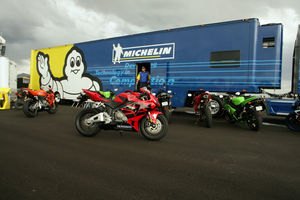Michelin Pilot Power 2CT
The best of both worlds. That's the feeling many manufacturers of modern-day sportbike tires want you to have when you buy their product(s). They want you to buy their tire with the knowledge that it will perform admirably on the track, so long as you're not in full-race mode (in most cases), and serve you even better on the street. All in the same day if you like.
As the performance level of the current crop of high-performance streetbikes and all-out sportbikes increases (seemingly exponentially), it follows then that tires must keep up with the escalating rise in horsepower. The battle for your attention and dollars in the tire arena has become just as competitive as the battle between bike makers.
Renowned tire maker, Michelin (authentically pronounced, mitch-a-lin) heeded the call of battle, and in July 2004 introduced the Pilot Power to the world. The Pilot Power utilizes many of the same, synthetic components that Michelin originally formulated for their MotoGP race tires. It was well received by the motorcycle press and buying public primarily for its great grip and quick warm-up time. Those two traits being a direct result of the tech borrowed from GP tires.
In the span of about one year after the Pilot was on the scene, Michelin was at it again, this time with a tire that was almost exclusively the domain of racetracks. The Power Race borrowed even more GP tire knowledge by way of its "two-compound" design. That design being a softer compound on each shoulder of the tire, and harder compound in the center. With a veritable smorgasbord of compound choices in the Power Race series, a rider has the choice of seven different configurations spread across three front and three rear tires.
As of September 2006 Michelin will have yet again expanded the Power series with the addition of the Pilot Power 2CT. Aggressive street riders-cum-track day junkies will now be able to enjoy even more trickle down technology. For the first time in the Power line, a rider will have access to a dual compound tire (hence the 2CT or "two compound technology"), without having to make the full leap to a race tire. With the 2CT, Michelin is bridging the gap between the Pilot Power and Power Race by offering a tire with a 20 percent softer compound on the tread shoulders. Although the outer edges of the tread are softer, you need not be concerned about tire life. According to Michelin, as the 2CT wears, "the proportion of softer rubber on the shoulder tread band widens" thereby maintaining longevity.
Along with the usual improved grip, responsiveness and "pure racing ingredients" construction, Michelin wants to impress upon us one more thing about their newest performance tire. With the 2CT (in dry conditions), Michelin claims that a rider can achieve a lean angle of 51.2 degrees, leaving a mere 3.8 degrees of separation between him or her and a GP bike that can attain a lean angle of 55 degrees. If we take them at their word, that's mighty impressive.
Make no mistake about it; Michelin still slots this tire as a street tire, but as a street tire for the rider who likes to mix up his or her riding exploits by going out and having a track day now and then. This got me to thinking, "Why would a potential consumer bother spending the extra money on the 2CT instead of sticking with the Pilot Power?" A quick call to Michelin media rep Dan Wildhirt, garnered the honest answer that " the Pilot Power is a capable track day tire, but the 2CT offers an extra advantage for the more aggressive or 'A' group track day rider."
In order to exhibit the tire's claimed performance, Michelin invited a smattering of motorjournalists to sample the 2CT at Miller Motorsports Park located in Tooele, Utah. Unfortunately, a full day on the track wasn't to be, as a ferocious monsoonal storm with winds of demonic proportions kicked up massive dust clouds and intermittent rainfall, limiting testing to just a few sessions for most. Nevertheless, it was enough time for me to come to at least one conclusion about the 2CT, and that is that it is consistent.
With a variety of the latest supersport bikes (Michelin opted not to use tire-shredding liter bikes, primarily because of the relatively new track surface at Miller) on site for the task at hand, the tire consistently came up to operating temperature quickly. It also consistently provided good feedback, stability and neutrality (for lack of a better term) so I could concentrate on riding each of the different bikes; rather than riding the tires on each bike. And grip, if nothing else about these new tires, was always consistent for me. I don't know if I achieved anywhere near 51.2 degrees of lean angle, but I do know that I was as confident as ever about leaning and occasionally dragging myself through many of the 12 turns of the West track.
As of September 2006 the 2CT will be available in a 120/70 ZR 17 for the front and either a 180/55 ZR 17 or a 190/55 ZR 17 for the rear. The only information at the time of the intro regarding retail costs was that the tire "should be about 15 percent more than the Pilot Power." Take that as you will; obviously prices will vary from vendor to vendor.
Michelin has an outstanding history in motorcycle racing, claiming 14 straight World Championships (10 of the 14 are split evenly between Doohan and Rossi) from 1992 to 2005. So, if their habit of passing down technology learned and earned from those Championships and others has translated successfully to the Pilot Power and Power Race, the Pilot Power 2CT should continue that same success.
More by Pete Brissette
































Comments
Join the conversation